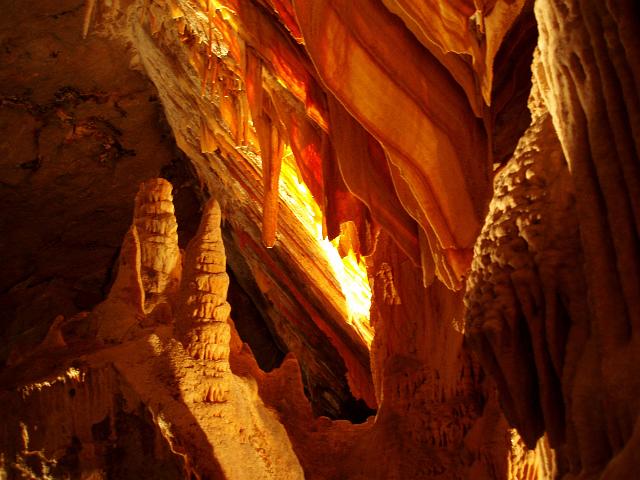Both form when dripping water deposits calcium carbonate and other minerals weathered form the rock above. Stalactites and stalagmites are most common limestone caves, although they also occur in lava tubes and even abandoned concrete builings.
 Stalactites form as, with each drip, a tiny ring of calcium carbonate is left on the cave roof. As more and more rings are added, the stalactite grows. Young stalactits have a straw-like structure, but if these fragile tubes become plugged by debris, the water begins to run down the outside as well as the inside, leading to the familar inverted cone shape. Stalactites can become extremely large - one hanging 63m from a roof in the Cueva de Nerja on Spain's Costa del Sol is claimed to be the world's longest stalactit so far measured.
Stalactites form as, with each drip, a tiny ring of calcium carbonate is left on the cave roof. As more and more rings are added, the stalactite grows. Young stalactits have a straw-like structure, but if these fragile tubes become plugged by debris, the water begins to run down the outside as well as the inside, leading to the familar inverted cone shape. Stalactites can become extremely large - one hanging 63m from a roof in the Cueva de Nerja on Spain's Costa del Sol is claimed to be the world's longest stalactit so far measured. Stalagmites - such as the so-called Totem Pole in the carlsbad Caverns of New Mexico, USA - grow upwards from the cave floor. Sometimes stalactites and stalagmites meet to form columns.
Another striking feature is a 'curtain' which is a wavy drape-like formation that hangs from the roof of a cave. This occurs if the angle of the roof inclines at an angle of around 45 degrees. Water runs down it, depositing calcium carbonate along a narrow line. The deposits build up and the resulting curtain grows in much the same way that a stalactite does. Such cave curtains can be found in the Wombeyan Caves in New South Wales, Australia.



No comments:
Post a Comment